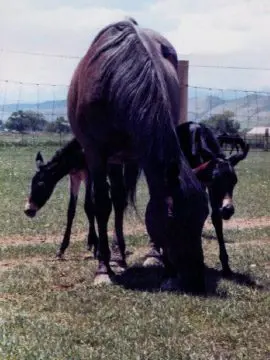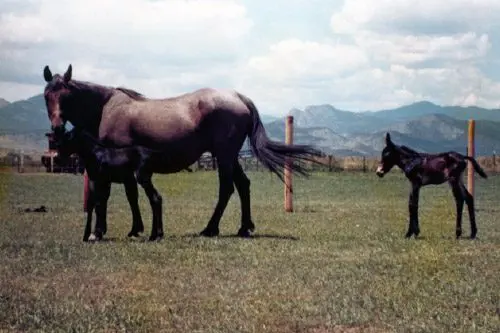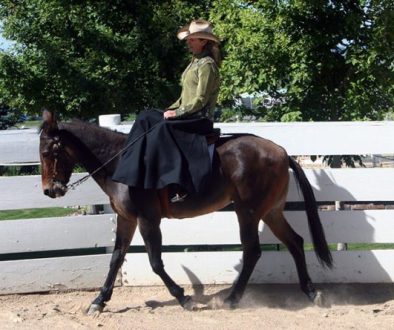MULE CROSSING: Missy’s Mule Twins
By Meredith Hodges
In 1987, the Fourth of July brought more than picnics, rodeos, and fireworks for John Thomas and his family of Berthoud, Colorado. They were blessed with the miracle of twin mules!
 The year before, John came down with a mild case of mule fever and decided to breed his red-road, half-Arabian mare, Missy, to Little Jack Horner here at the Lucky Three Ranch in Loveland. The breeding went smoothly and the mare was sent home. She returned 15 days later for her ultra-sound pregnancy check, at which time we discovered she had conceived twins. Since the twins posed a life-threatening situation, Kent Knebel, D.V.M., our attending veterinarian and I advised John of his options. We could abort the twins and start over or we could abort one and hope the other survived. The third and most risky choice would be to let nature run its course and hope for the best. John opted for the latter and took Missy home. She would be due to foal in August.
The year before, John came down with a mild case of mule fever and decided to breed his red-road, half-Arabian mare, Missy, to Little Jack Horner here at the Lucky Three Ranch in Loveland. The breeding went smoothly and the mare was sent home. She returned 15 days later for her ultra-sound pregnancy check, at which time we discovered she had conceived twins. Since the twins posed a life-threatening situation, Kent Knebel, D.V.M., our attending veterinarian and I advised John of his options. We could abort the twins and start over or we could abort one and hope the other survived. The third and most risky choice would be to let nature run its course and hope for the best. John opted for the latter and took Missy home. She would be due to foal in August.
The incidence of twins in equines is rare. If they are conceived, they rarely make it through the birth process. The primary reasons for this are the lack of nutrients to  sustain two fetuses and the way the uterus contracts during the birth process. In a dog, cat, or animal given to litters, the uterus contracts in segments, giving each baby an opportunity to “line-up” for birth. In equines, the uterus contracts as a whole, often causing both babies to be pushed into the birth canal together. This usually ends in disaster. Before birth, a stronger twin may horde the larger part of the mother’s nutrients causing the second twin’s growth to be stunted. The degree of deprivation determines whether the smaller twin can survive, provided they both make it through the birth process. Either way, twins in equines are an extremely risky situation.
sustain two fetuses and the way the uterus contracts during the birth process. In a dog, cat, or animal given to litters, the uterus contracts in segments, giving each baby an opportunity to “line-up” for birth. In equines, the uterus contracts as a whole, often causing both babies to be pushed into the birth canal together. This usually ends in disaster. Before birth, a stronger twin may horde the larger part of the mother’s nutrients causing the second twin’s growth to be stunted. The degree of deprivation determines whether the smaller twin can survive, provided they both make it through the birth process. Either way, twins in equines are an extremely risky situation.
In early June, I heard from John again. Missy was enlarging rapidly and John was concerned about her welfare. She was on pasture and could not be watched closely. We agreed that she should return to the Lucky Three Ranch for foaling where she could be monitored more carefully. In mid-June, Missy returned to the Lucky Three Ranch. She was positively enormous… bearing a stark resemblance to a rhinoceros! It was inconceivable that she would carry full term.
A pre-partum vet check revealed some doubt about there still being twins. Kent checked Missy and was only able to feel one baby inside. He said there was a possibility that one of the twins may have been absorbed, or was very small and hidden beneath the other. Otherwise, the mare’s condition was excellent. There was nothing to do but wait!
 In two weeks, Missy dropped some of her weight and began to look more like a pregnant mare again. Apparently the unsupervised pasturing had allowed her to become somewhat obese. She began to wax after two weeks and we were ready for action, but she fooled us. The waxing stage came and went and she began streaming milk wherever she walked. On July 3, Dr. Knebel took another look at her while he was out at the ranch tending to another patient. “Looks like a firecracker birth to me…” he announced, “or maybe the day after.”
In two weeks, Missy dropped some of her weight and began to look more like a pregnant mare again. Apparently the unsupervised pasturing had allowed her to become somewhat obese. She began to wax after two weeks and we were ready for action, but she fooled us. The waxing stage came and went and she began streaming milk wherever she walked. On July 3, Dr. Knebel took another look at her while he was out at the ranch tending to another patient. “Looks like a firecracker birth to me…” he announced, “or maybe the day after.”
Every hour, on the hour, we checked her throughout the night. Finally at the 4:00 A.M. check, I was greeted by two darling new faces, one jet black and the other dark bay…the twins had arrived! Missy apparently had a relatively easy birth. The twins were fine, one only slightly smaller than the other. There were no tears or signs of strain on the mare and the placenta was intact after being expelled. I treated the twins’ umbilical cords with iodine, saw to it that they both nursed and then gave them both enemas to assure that the meconium was passed. The proud mother watched carefully as a multitude of visitors came to view the result of this miraculous birth on the Fourth of July. Conceived on John’s birthday and born on the Fourth of July, the twins gave John a real good dose of Mule Fever! He decided to breed Missy again the same year, though he felt one baby would be sufficient next time. Little Jack Horner’s bray could be heard for miles… braying the victory of a very proud father!
Missy was not the only mare to successfully foal with mule twins this year. In April of 1987, Ron and Marsha Talbot of California had a mare foal with twins and Ann Greer-Rankine of the Thunderbolt Jack Station in Wyoming reported a set of twins by their jack, Scott’s Gallant Eagle.
It seems in Missy’s case, we had all the right things going for us. She is an aged broodmare, stretched out enough from previous births to accommodate the twins. Because the twins are mules, they are stronger and better able to grow on less nourishment than are horse babies. They are also born smaller, so their chances of manipulating into position for birth are better. And lastly, both of Missy’s foals were females, the stronger of the two sexes.
It is interesting to discover that the incidence of twin mules is greater than that of twin horses. The primary reason is that mule foals are typically smaller than horse foals and have a better chance at survival. We can only marvel at these miracles and hold dear the uniqueness of these wonderful long-eared animals! Congratulations to the long-eared twins of 1987!
To learn more about Meredith Hodges and her comprehensive all-breed equine training program, visit LuckyThreeRanch.com, MEREDITH HODGES PUBLIC FIGURE Facebook page, or call 1-800-816-7566. Check out her children’s website at JasperTheMule.com. Also, find Meredith on Pinterest, Instagram, MeWe, YouTube and Twitter.
Covered in TRAINING MULES & DONKEY: A LOGICAL APPROACH TO TRAINING, TRAINING WITHOUT RESISTANCE and EQUUS REVISITED at www.luckythreeranchstore.com.
© 1987, 2016, 2024 Lucky Three Ranch, Inc. All Rights Reserved.




